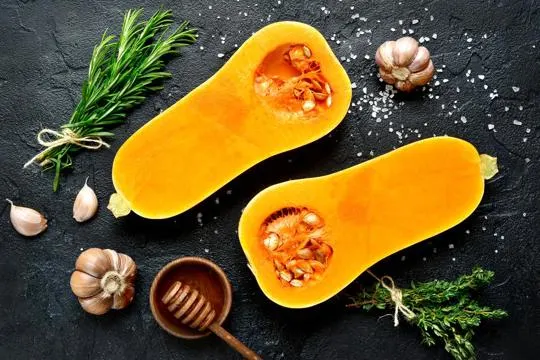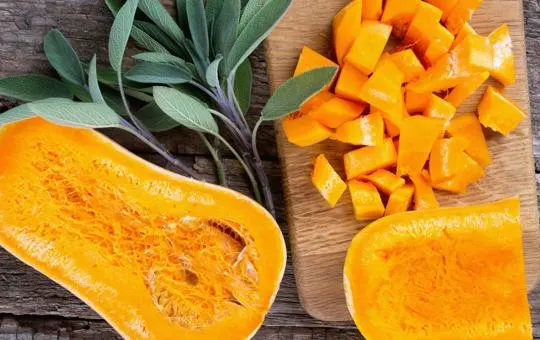Squash and pumpkin often get mixed up in the kitchen. Both belong to the same family, yet they’re not the same.
Squash is versatile, fit for any dish. On the other hand, pumpkins steal the show every Halloween. They have distinct tastes, textures, and uses.
We’ve all been there, standing in the produce aisle, debating what to pick. Pumpkins are the go-to for pies and spooky carvings. Squash? It’s our year-round buddy in soups and salads. Key point: they serve different purposes.
Our kitchens have seen both squash and pumpkin fails. Remember that time the “pumpkin” soup was actually butternut squash? Classic mix-up.
Here, we’ll clear the confusion. No more guessing games. This is the lowdown on squash versus pumpkin.
What is Squash?

Squash is a unique veggie.
With a tough skin and vibrant colors like yellow, green, and orange, it’s part of the gourd family.
It has a high water content, making its flesh tender and mild in flavor.
Squash can be cooked in lots of ways – roast, steam, or mash.
Perfect for soups and stews.
This veggie also has lots of health benefits.
It’s packed with vitamins A, C, and E.
Plus, fiber to help digestion and keep you slim.
Compared to pumpkins, squash has thinner skin and a milder taste.
Pumpkins usually have more fibrous flesh, which is great for baking.
So, in conclusion, squash is a great addition to any meal.
It’s versatile and flavorful, plus it’s good for you.
What is Pumpkin?

Pumpkin, a multi-purpose fruit, is renowned for its bright orange hue and special flavor.
It’s part of the Cucurbitaceae family; which includes squash and gourds.
Pumpkins come in various sizes and can reach hefty weights.
They’re usually linked to fall events, particularly Halloween and Thanksgiving.
For hundreds of years, pumpkins have been grown and are native to North America.
Their culinary use is renowned, in sweet and savory dishes.
Pumpkin pie is a traditional autumn dessert and roasted pumpkin seeds make for a yummy snack.
Pumpkins can also be cooked into soups or used as an ingredient in other recipes.
Pumpkins have decorative purposes too.
People often carve intricate patterns into them to create jack-o’-lanterns, adding a creepy touch to Halloween festivities.
Their bright colors and unique shapes make them popular as centerpieces or outdoor decorations during the harvest season.
Nutritionally speaking, pumpkins are low in calories but high in vitamins A and C.
They also contain minerals like potassium and magnesium.
Though typically associated with autumn, pumpkins can be found all year round in canned puree or frozen chunks.
Differences Between Squash and Pumpkin

Squash and pumpkin share similarities, but each has its own unique characteristics.
Appearance and Size
Squash and pumpkins are similar, yet different.
They both show off vibrant colors from deep green to bright orange.
Squash has a smooth, glossy skin, while pumpkin has a distinctive ribbed exterior.
Squash comes in many sizes, from small to large, while pumpkins are usually bigger.
It’s amazing how nature provides so much variation within one family.
When we take a closer look, there are many types of squash, such as acorn, butternut, and spaghetti squash.
Each has unique shapes and sizes, making them great for cooking.
Pumpkin also comes in various cultivars, including sugar pie, Cinderella, and Lumina.
Every one brings something special to the table.
Let’s not forget about the seeds.
Both squash and pumpkin have edible seeds that are nutritious and tasty when roasted or baked.
But, squash seeds tend to be smaller than pumpkin seeds.
Flavor and Taste
Squash and pumpkin have distinct flavors.
Squash is usually mild and sweet, with nutty notes.
Pumpkin tends to be stronger and earthy.
Squash is great for both savory and sweet dishes.
Meanwhile, pumpkin is popular for autumn flavors like cinnamon, nutmeg, and cloves.
The taste of squash and pumpkin can vary depending on the variety.
Both offer unique flavors, perfect for any dish.
Culinary Uses
Squash and pumpkin look similar, but are used differently in the kitchen.
Squash is often cooked and served as a savory dish.
Pumpkins are commonly used in sweet treats like pies and desserts.
Certain types of squash can be dried and ground to make a flour-like substance.
This is a gluten-free option for baking.
Both squash and pumpkin can be roasted or pureed for recipes.
Pumpkins are usually carved for Halloween decorations.
Each vegetable is versatile and can be used for culinary creativity.
Nutritional Content
Squash and pumpkin, though resembling one another, have quite unique nutritional profiles.
Squash gives us dietary fiber and vitamins A and C.
Pumpkins, in contrast, contain beta-carotene, potassium, and vitamin E antioxidants.
Both veggies are beneficial, but their individual nutrient content is what sets them apart.
Similarities Between Squash and Pumpkin

Squash and pumpkin can be hard to tell apart.
Both are part of the Cucurbitaceae family and are winter veggies.
They have a similar, firm texture, great for roasting or pureeing.
Plus, they both have lots of vitamins and minerals.
And, they look great as seasonal decorations.
Taste-wise, they both have a hint of sweetness.
But, depending on the type, one can be milder than the other.
They can both be used in multiple recipes, from soup to dessert.
However, there are differences too.
Pumpkins tend to be bigger and rounder.
Squash come in various shapes, like butternut or acorn.
Also, certain types of squash, like zucchini or yellow squash, have a milder flavor than pumpkins.
Still, it can be hard to tell them apart.
Some winter squash look and taste just like pumpkins.
Types and Varieties of Squash and Pumpkin
Squash and pumpkins – distinct.
Acorn, butternut, and spaghetti squash – types of squash.
Sugar Pie, Jack-o’-lantern, and Cinderella – pumpkin varieties.
Distinguish between? Roast or use in desserts – squash.
Savory dishes – mild flavor profiles.
Pumpkins – sweeter taste.
Traditional fall recipes – pumpkin pie, pumpkin soup.
Explore the world – shapes, sizes, colors, textures, flavors – enhance culinary adventures.
How to Cook Squash and Pumpkin?
Cooking squash and pumpkin can be similar.
But, there are some key differences.
Start by cutting them open and removing the seeds and pulp.
Roast, steam, boil, sauté, or puree them.
Both are great for soups, stews, or sides.
Squash has a dense and sweet flavor.
Pumpkins have a milder taste.
Enhance their flavors with spices and seasonings.
Have fun exploring the versatility of these fall favorites.
Conclusion
So, as we have now explored, squash and pumpkins are both members of the Cucurbitaceae family.
Despite their close botanical kinship, however, a few notable differences separate the two.
Squash is often grated into recipes while pumpkin typically takes on a sweeter role in desserts or soups.
But both vegetable varieties are high in dietary fiber and valuable vitamins and minerals — not to mention they are incredibly beautiful throughout all seasons.
It’s easy to forget that these common kitchen items can also serve as stunning decorations and centerpieces — so be sure to appreciate the aesthetic of squash and pumpkins just as much as you do their nutritious benefits.
Whether you use them for cooking, decorating or serving simply out of curiosity about their qualities – there’s no denying that this confusion-breaking comparison was well worth exploring.

Leave a comment